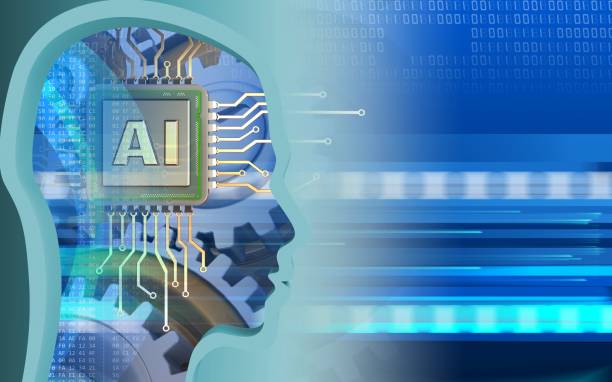### What is Artificial Intelligence? Definitions, Concepts, and History
[Image: Hand clicking on CRM or customer relationship management]
**Artificial Intelligence** (AI), in short, refers to the ability of a computer system to mimic human cognitive functions such as learning, reasoning, and problem-solving.
This broad field includes a variety of techniques and approaches aimed at creating machines that can perform tasks that currently require human intelligence.
The historical roots of #Artificial_Intelligence can be traced back to early efforts to build thinking machines and develop problem-solving algorithms in the 1950s and 1960s.
Significant advances in recent decades, particularly in the fields of machine learning and neural networks, have led to the emergence of powerful #Artificial_Intelligence systems capable of performing complex tasks such as facial recognition, language translation, and self-driving cars.
In fact, artificial intelligence is trying to build machines that are not only capable of processing data and executing instructions, but also capable of learning from their experiences, making informed decisions, and even being creative.
Artificial intelligence is more than just a technology; it is also a #Philosophical_Challenge.
It raises questions about what intelligence is, how consciousness arises, and what the difference is between human intelligence and machine intelligence.
As artificial intelligence advances, these questions become more important and force us to redefine our understanding of ourselves and our place in the world.
>Don’t have a company website yet and missing out on online opportunities? With a professional corporate website design by Rasaweb,
>
>✅ Double the credibility of your business
>
>✅ Attract new customers
>
>⚡ Free consultation for your company website!
### Types of Artificial Intelligence: Approaches and Applications
[Image: Control smart ai technology big data system cyberspace]
Artificial intelligence can be categorized based on various criteria.
A common classification is based on the level of AI capabilities.
Accordingly, there are three main types of artificial intelligence:
1. **Narrow AI:** This type of AI is designed to perform a specific task and performs excellently in that task.
Most AI systems we encounter today are of this type, such as facial recognition systems, movie recommendation systems, and computer games.
2. **General AI:** This type of AI, which is still in the theoretical stage, will be able to perform any task that a human can do, as well as or even better.
3. **Super AI:** This type of AI, which goes beyond human intelligence, will be able to outperform humans in all fields.
Another classification is based on the approaches used in the development of artificial intelligence.
The two main approaches in this field are:
1. **Machine Learning:** This approach focuses on training machines using data.
Machines analyze data, identify patterns, and learn how to make decisions or make predictions.
2. **Expert Systems:** This approach focuses on creating systems that simulate the knowledge and expertise of a human expert in a specific field.
Expert systems use logical rules and reasoning to solve problems and provide advice.
Applications of #Artificial_Intelligence are vast and diverse, affecting almost all aspects of our lives.
Some of the most important applications of artificial intelligence include:
1. **Healthcare:** Diagnosing diseases, developing new drugs, providing personalized care
2. **Automotive:** Self-driving cars, improving vehicle safety, optimizing fuel consumption
3. **Finance:** Fraud detection, risk management, providing personalized financial services
4. **Manufacturing:** Automating processes, quality control, predicting equipment failure
5. **Education:** Personalizing learning, providing automatic feedback, developing new educational tools
### Machine Learning: The Beating Heart of Artificial Intelligence
[Image: Futuristic ai technology background with circuit lines and g]
Machine learning is a subset of artificial intelligence that allows machines to learn from data without explicit programming.
In other words, instead of giving machines precise instructions to perform a specific task, they use machine learning algorithms to identify patterns in the data and learn how to make decisions or make predictions.
Machine learning algorithms are divided into different types, including:
1. **Supervised Learning:** In this type of learning, the machine is trained using labeled data.
Labeled data is data for which the correct answer is specified for each input.
By analyzing this data, the machine learns how to map inputs to correct outputs.
2. **Unsupervised Learning:** In this type of learning, the machine is trained using unlabeled data.
The machine must automatically identify patterns in the data.
3. **Reinforcement Learning:** In this type of learning, the machine learns how to take actions that maximize reward by interacting with an environment.
The machine learns which actions lead to rewards and which actions lead to penalties through trial and error.
Machine learning is used in a wide range of applications, including:
1. **Facial recognition**
2. **Voice recognition**
3. **Language translation**
4. **Product recommenders**
5. **Fraud detection**
Machine learning is constantly evolving and is expected to play an increasingly important role in the future of artificial intelligence.
In fact, many recent advances in artificial intelligence, such as the development of self-driving systems and virtual assistants, are due to advances in machine learning.
| Learning Type | Description | Example |
| :——————- | :————————————————– | :————————- |
| Supervised Learning | Learning using labeled data | Image recognition |
| Unsupervised Learning| Learning using unlabeled data | Customer clustering |
| Reinforcement Learning| Learning by interacting with an environment | Computer games |
### Neural Networks: Inspired by the Human Brain
[Image: dubbele blootstelling van creatieve kunstmatige afkorting va]
Neural networks are computational models inspired by the structure and function of the human brain.
A neural network consists of a large number of processing units called neurons, which are connected in layers.
Each neuron receives signals from other neurons, processes them, and produces an output signal.
The output signal of each neuron is transmitted to other neurons in the next layer.
Neural networks are widely used in machine learning, especially in areas such as:
1. **Image recognition**
2. **Voice recognition**
3. **Language translation**
4. **Natural language processing**
Neural networks can identify complex patterns in data and perform tasks that are difficult or impossible for humans.
One of the most important features of neural networks is the ability to learn deeply.
Deep Learning allows neural networks with many layers to extract more complex features from data.
Deep neural networks have made significant advances in many areas of #Artificial_Intelligence in recent years.
For example, today’s facial recognition and language translation systems use deep neural networks.
Neural networks are a powerful tool for solving complex problems and are expected to play an increasingly important role in the future of artificial intelligence.
>Is your online store ready to attract maximum customers and increase sales? Rasaweb transforms your online business by designing modern and efficient online stores.
>
>✅ Increase speed and improve SEO
>
>✅ Excellent user experience on mobile and desktop
>
>⚡ Get a free consultation on online store design from Rasaweb!
### Natural Language Processing (NLP): Understanding and Producing Human Language
[Image: hands-coding-on-laptop-with-ai-brain-circuit-icon-and-html-i]
Natural Language Processing (NLP) is a branch of artificial intelligence that allows computers to understand, interpret, and produce human language.
The goal of NLP is to create systems that can communicate with humans in natural language and perform tasks that require language understanding.
NLP includes a wide range of tasks, including:
1. **Text analysis**
2. **Language translation**
3. **Text summarization**
4. **Text generation**
5. **Dialogue**
NLP is used in a wide range of applications, including:
1. **Search engines**
2. **Virtual assistants**
3. **Machine translation**
4. **Sentiment analysis**
5. **Chatbots**
NLP is constantly evolving and is expected to play an increasingly important role in the future of human-machine communication.
With the advancement of NLP, computers will be able to understand human language more accurately and completely and communicate with humans in more natural and effective ways.
### Robotics and Artificial Intelligence: Collaboration to Build Smart Machines
[Image: head-silhouette-with-particles-on-a-dark-blue-background-dat]
Robotics and artificial intelligence are two related fields that, by working together, create smart machines that are capable of performing complex tasks in the real world.
Robotics deals with the design, construction, operation, and application of robots, while artificial intelligence deals with the development of systems that are capable of mimicking human cognitive functions.
When artificial intelligence is combined with robotics, robots are able to:
1. **Sense their environment**
2. **Make decisions**
3. **Learn**
4. **Interact with their environment**
Robots equipped with artificial intelligence can be used in a wide range of applications, including:
1. **Manufacturing**
2. **Healthcare**
3. **Agriculture**
4. **Services**
5. **Exploration**
With the advancement of artificial intelligence and robotics, intelligent robots are expected to play an increasingly important role in our lives.
These robots can help us perform difficult and repetitive tasks, improve our quality of life, and create new opportunities for innovation and progress.
### Ethics in Artificial Intelligence: Challenges and Considerations
[Image: etf-exchange-traded-fund-stock-market-trading-investment-fin]
The development and use of artificial intelligence raises important ethical challenges.
As artificial intelligence advances, we must answer the questions of how we can use artificial intelligence responsibly and ethically and prevent its potential harms.
Some of the most important ethical challenges in artificial intelligence include:
1. **Bias:** Artificial intelligence systems can learn and reproduce biases present in training data.
This can lead to unfair and discriminatory decisions.
2. **Transparency:** Decisions made by artificial intelligence systems are often inexplicable.
This can reduce trust in these systems and make accountability difficult.
3. **Privacy:** Artificial intelligence systems can collect and process a lot of personal information.
This can raise concerns about privacy and misuse of information.
4. **Employment:** Automation based on artificial intelligence can lead to job losses in some industries.
5. **Control:** With the advancement of artificial intelligence, the question arises of how we can prevent artificial intelligence systems from getting out of control.
To address these ethical challenges, we must take steps, including:
1. **Developing bias-free algorithms**
2. **Increasing the transparency of artificial intelligence systems**
3. **Protecting privacy**
4. **Creating new job opportunities**
5. **Developing ethical standards for artificial intelligence**
| Ethical Challenge | Explanation | Proposed Solution |
| :—————- | :—————————————————————————————————— | :————————————————— |
| Bias | Artificial intelligence systems can learn biases present in the data | Develop bias-free algorithms |
| Transparency | Decisions made by artificial intelligence systems are often inexplicable | Increase the transparency of artificial intelligence systems |
| Privacy | Artificial intelligence systems can collect and process a lot of personal information | Protecting privacy |
### The Future of Artificial Intelligence: Opportunities and Threats
[Image: graphic-featuring-ai-brain-and-futuristic-infographic-elemen]
Artificial intelligence is creating profound changes in the world and is expected to play an increasingly important role in the future.
The #Future_of_Artificial_Intelligence provides countless opportunities for progress and improving human lives.
Artificial intelligence can help us solve complex problems, improve efficiency, create new products and services, and improve the quality of life.
However, artificial intelligence also carries threats.
These threats include:
1. **Job loss**
2. **Privacy**
3. **Discrimination**
4. **Automatic wars**
In order to be able to fully benefit from the opportunities of artificial intelligence and prevent its threats, we must use this technology responsibly and ethically.
We must develop ethical standards for artificial intelligence, protect privacy, prevent discrimination, and prevent the development of automatic wars.
The future of artificial intelligence is in our hands.
We can determine with our decisions what direction this technology will take and what impact it will have on the world.
>Is your online sales not as expected? With Rasaweb, solve the problem of low sales and poor user experience forever!
>
>✅ Increase visitor-to-customer conversion rate
>
>✅ Create an enjoyable user experience and increase customer confidence
>
>⚡ Take action now to receive a free consultation!
### Artificial Intelligence in Iran: Current Status and Outlook
[Image: concepts-development-of-artificial-intelligence-and-self-lea]
Artificial intelligence in Iran, like other parts of the world, has received attention, and a lot of research and development activities in this technology are underway.
[IranNLP](https://irannlp.ir/) is one of the references for the Persian language.
In Iran, artificial intelligence is used in various fields such as:
1. **Healthcare**
2. **Industry**
3. **Agriculture**
4. **Services**
Also, a number of knowledge-based companies and startups in Iran are active in the field of artificial intelligence and produce and offer products in this field.
The Iranian government also supports the development of artificial intelligence and has developed programs for the development of this technology in the country.
Given the existing potentials in Iran, artificial intelligence is expected to play an increasingly important role in the country’s economic and social development in the future.
### How Can We Prepare for the Age of Artificial Intelligence?
[Image: hand clicking on crm or customer relationship management but]
Artificial intelligence is changing the world, and in order to succeed in this new world, we must prepare ourselves for the age of artificial intelligence.
To prepare for the age of artificial intelligence, we must:
1. **Learn new skills:** We must learn skills that are necessary to work with and use artificial intelligence systems.
These skills can include programming, data analysis, machine learning, and critical thinking skills.
2. **Change our perspective:** We must change our perspective on work and life.
We must learn how to collaborate with artificial intelligence systems and use them to improve our efficiency and creativity.
3. **Be committed to lifelong learning:** Artificial intelligence is constantly evolving, and in order to keep pace with this progress, we must be committed to lifelong learning.
We must constantly learn new skills and keep our knowledge up to date.
4. **Take advantage of new opportunities:** Artificial intelligence provides new opportunities for entrepreneurship, innovation, and progress.
We must take advantage of these opportunities and come up with new ideas for using artificial intelligence in various fields.
By preparing for the age of artificial intelligence, we can benefit from the countless opportunities that this technology offers and create a brighter future for ourselves and society.
#### FAQ
| Question | Answer |
| :————————————————————————— | :————————————————————————————————————————————————————————————————————————————————————- |
| What is artificial intelligence? | It is a simulation of human intelligence in machines programmed to think like humans and mimic their actions. |
| What are the main branches of artificial intelligence? | Includes machine learning, deep learning, natural language processing, computer vision, and robotics. |
| What is Machine Learning? | It is a branch of artificial intelligence that focuses on enabling systems to learn from data and identify patterns without explicit programming. |
| Mention examples of artificial intelligence applications in our daily lives. | Voice assistants (such as Siri and Alexa), recommendation systems in Netflix and Amazon, self-driving cars, and facial recognition software. |
| What is Deep Learning? | It is a subset of machine learning that uses artificial neural networks with multiple layers (deep) to process large amounts of data. |
| What is Natural Language Processing (NLP)? | It is a branch of artificial intelligence that focuses on enabling computers to understand, interpret, and generate human language. |
| What are some ethical concerns related to artificial intelligence? | Includes data bias, privacy, job loss, and accountability in case of errors. |
| What are the main benefits of artificial intelligence? | Increased efficiency, improved decision-making, automation of repetitive tasks, and discovery of complex patterns in data. |
| How is artificial intelligence used in healthcare? | In disease diagnosis, drug discovery, medical image analysis, and personalized patient care. |
| How do you see the future of artificial intelligence? | It is expected to continue to evolve at a rapid pace, affecting all aspects of human life, from industry to education and entertainment. |
**And other services of Rasa Web Advertising Agency in the field of advertising:**
**Intelligent Brand Identity:** A combination of creativity and technology to increase sales by designing an attractive user interface.
**Intelligent UI/UX:** A creative platform for improving customer behavior analysis with attractive user interface design.
**Intelligent Google Ads:** Designed for businesses looking to manage campaigns through SEO-based content strategy.
**Intelligent Customer Journey Map:** A dedicated service for increasing website visits based on marketing automation.
**Intelligent Content Strategy:** An effective tool for managing campaigns with the help of SEO-based content strategy.
**And more than hundreds of other services in the field of internet advertising, advertising consulting, and organizational solutions**
**Internet Advertising | Advertising Strategy | Advertisement Reports**
Are you ready to transform your business in the digital world? Rasaweb Afarin Digital Marketing Agency, by providing comprehensive and innovative services including [responsive website design](https://share.google/mQBI2uMQ2UUYhTmkx), professional SEO, and intelligent social media management, is your strategic partner on the path to growth and success.
📍 Tehran, Mirdamad Street, next to the Central Bank, South Kazerun Alley, Ramin Alley No. 6
✉️ [info@idiads.com](mailto:info@idiads.com)
📱 [09124438174](tel:+989124438174)
📱 [09390858526](tel:+989390858526)
📞 [02126406207](tel:+982126406207)
#### Resources
[What is Artificial Intelligence? (An Introduction to Artificial Intelligence)](https://www.virgool.io/@mostafa96/ai-introduction-to-artificial-intelligence-hcz4y5nh3y53)
,[What is Artificial Intelligence and what are its applications?](https://www.ictjournal.ir/artificial-intelligence/5561-%D9%87%D9%88%D8%B4-%D9%85%D8%B5%D9%86%D9%88%D8%B9%DB%8C-%DA%86%DB%8C%D8%B3%D8%AA-%D9%88-%DA%86%D9%87-%DA%A9%D8%A7%D8%B1%D8%A8%D8%B1%D8%AF%DB%8C-%D9%87%D8%A7%DB%8C%DB%8C-%D8%AF%D8%A7%D8%B1%D8%AF%D8%9F)
,[What is Artificial Intelligence? A complete and simple explanation of Artificial Intelligence](https://aminrahimi.com/blog/what-is-ai/)
,[Artificial Intelligence and the Future of Psychology](https://www.webyad.com/%D9%87%D9%88%D8%B4-%D9%85%D8%B5%D9%86%D9%88%D8%B9%DB%8C-%D9%88-%D8%A2%DB%8C%D9%86%D8%AF%D9%87-%D8%B1%D9%88%D8%A7%D9%86%D8%B4/)




